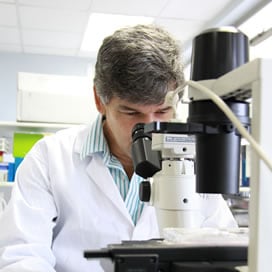Doctor Adrie JC Steyn
The Mystery of PersistenceAgilent helps investigators search for ways to beat tuberculosisEvery 15 seconds, someone dies from tuberculosis, or TB, as it is commonly known. "Way back in the 1950s, when TB drugs were discovered, we thought TB was going to be cured," says Adrie Steyn. "Now we know that’s not the case. TB has not been cured." Tuberculosis has become resistant to existing treatments, spawning new categories of TB such as MDR (multidrug resistant) and XDR (extensively drug resistant). "We are in desperate need of a new vaccine or drug because a third of the world’s population—that’s 2 billion people—is latently infected with TB," says Steyn, a leading researcher in the field. He has been studying tuberculosis for 20 years and now coordinates the research of two analytical laboratories—one in Birmingham, Alabama, the other in Durban, South Africa—and collaborates with a third in Madrid, Spain. All three rely on technology from Agilent.
Tuberculosis is particularly prevalent in South Africa, which is why the Howard Hughes Medical Institute decided to build a state-of-the-art research center in Durban—“to study the disease where the disease is,” as Steyn puts it. When he was asked to head an analytical laboratory in Durban, Steyn’s first request was for the same cell analysis system he had been using at the University of Alabama at Birmingham, where colleagues helped develop the Seahorse XF. The technology, acquired by Agilent earlier this year, enables researchers to better understand cell health, function, and signaling—and how introducing a specific drug may impact the cell—by delivering real-time, nondestructive measurements of living cells. "We are uniquely positioned here,” Steyn says. “As far as I know, we are the only institution in the world with routine access to freshly resected lung tissue samples from TB patients." The Africa Health Research Institute* receives three or four samples a week from local surgeons, who often must remove part of a lung, or even a whole lung, from one of their TB patients. What that means for Steyn and his fellow researchers is that they can move beyond animal models. "We know a lot about TB in animals—monkeys, mice, rabbits—but there is no single animal that fully mimics the whole spectrum of the human form of the disease,” Steyn says. “We now have the opportunity for the first time to routinely study human samples." Steyn and his teams hope to unravel the underlying mechanisms of the disease. "How is it that TB can persist undetected in a human being for 20 years and suddenly one day just explode into disease?" he asks. "What are those host genes that allow TB to enter a dormant state, maintain that dormant state, and at some point emerge from it? That we just don’t know. We have absolutely no idea."
Steyn has adapted Agilent Seahorse XF technology to the study of tuberculosis, using it to examine how the disease reprograms cell metabolism and bioenergetics—in real time. But even that approach, by itself, has its limitations. "Here, and in the United States, we have really state-of-the-art facilities, but we lack certain instruments," he says. "That’s why I’m collaborating with people in Europe, people like Coral Barbas, who is phenomenal." Dr. Barbas is the founder and director of the Center for Metabolomics and Bioanalysis in Madrid. Researchers from around the world bring samples to her Agilent-equipped analytical laboratory for metabolic profiling. "I was invited to Adrie´s lab, and he told me about his work with Seahorse,” she says. “I quickly saw the relationship with the metabolomic research I’ve been doing, so we decided to develop a project to show how Seahorse analyzers and mass spectrometry (GC/MS, LC/MS, and CE/MS) can complement each other." Seahorse XF technology provides a metabolic phenotype, in live cells, that helps to determine whether functional changes have taken place, and which pathway or pathways may be affected. These results can then be used to inform and guide the design of the mas-spec analysis. In this way, the combination of Seahorse XF and Agilent mass spec-based metabolomics can facilitate a more integrated view of metabolism in biological models. “The most exciting thing for me is the opportunity to combine and integrate cutting-edge technologies with human samples. Few institutions have that opportunity,” Steyn says. "Ultimately, we (and the whole field) are looking for a drug to kill dormant TB. If we can do that, we can potentially save millions and millions of lives." *The Africa Health Research Institute (AHRI) was established on October 1, 2016, as a merger between the Africa Centre for Population Health and the KwaZulu-Natal Research Institute for TB-HIV. It is made possible through support from Wellcome Trust and the Howard Hughes Medical Institute. AHRI is a cross-disciplinary research institute, focusing on HIV, TB, and related conditions. |

Adrie JC Steyn, PhD
Investigator, Africa Health Research Institute (AHRI), Durban, South Africa |
Selected publications
|
Host-pathogen redox dynamics modulate Mycobacterium tuberculosis pathogenesis. Ferritin H Deficiency in Myeloid Compartments Dysregulates Host Energy Metabolism and Increases Susceptibility to Mycobacterium tuberculosis Infection. Role of Ergothioneine in Microbial Physiology and Pathogenesis. Mycobacterium tuberculosis arrests host cycle at the G1/S transition to establish long term infection. Turning the respiratory flexibility of Mycobacterium tuberculosis against itself. |